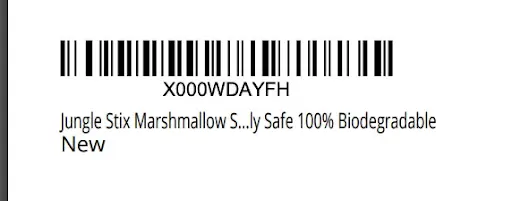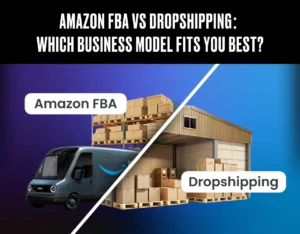Want to know what an Amazon FNSKU barcode is and how to create one for your FBA products? You’re in the right place. FNSKU barcode is an essential requirement for registering an inventory in FBA. Applying the barcode label correctly is important for smooth stock logging, product tracking, and order processing.
This article will break down everything you need to know about an Amazon FNSKU barcode. Learning about this important Amazon identifier is the key to smooth inventory tracking on Amazon FBA.
Part 1: What is Amazon FNSKU Barcode?
Amazon FNSKU (Fulfillment Network Stock Keeping Unit) is a special identifier code for Amazon FBA sellers. It helps Amazon track inventory and monitor product movement in its storage centers.
When you list a product on FBA, Amazon generates an FNSKU barcode. The code is unique to both the merchant and the product. This ensures that your inventory is exclusive to you, irrespective of other entrepreneurs selling the same product.
Key Features of Amazon FNSKU Barcode
Below are the primary characteristics of an Amazon FNSKU barcode.
- Mandatory for product listings on Amazon FBA.
- Keeps inventory separate from other sellers.
- Error-free order processing and seamless returns.
- Accurate product storage and tracking.
- Helps Amazon track and manage your items.
Part 2: FNSKU vs ASIN
Hearing the two terms FNSKU and ASIN repeatedly, you must be wondering what the difference is. Both are Amazon product barcodes, but ASIN is product-specific, while the FNSKU barcode identifies the products from a specific seller.
What is ASIN?
ASIN (Amazon Standard Identification Number) is a ten-digit serial number assigned to a specific product unit. All the same products have the same ASIN, regardless of whether they are being sold by different merchants. This barcode identifies the same product across all sellers in Amazon’s inventory.
What is FNSKU?
In contrast, the FNSKU is a product- and seller-specific identifier code in Amazon FBA. This is unique for both the seller and the product. FNSKU helps to keep your inventory separate, even if you sell the same product.
Learn more about what an ASIN is and how it differs from an FNSKU in our detailed guide on What is an Amazon Standard Identification Number and How to Create It?
Part 3: How To Create an FNSKU Barcode
You can create an FNSKU barcode by listing your product in the FBA program. Let’s see how you can do all of this process in 3 easy steps:
Step 1: Product Listing on FBA
Log in to your Amazon Seller Central account. Create a new product listing and set up with FBA (Fulfilled by Amazon).
Step 2: Amazon generates an FNSKU
Once the product is successfully listed, Amazon auto-generates an FNSKU barcode for the unit.

Step 3: Download the FNSKU Barcode
In Seller Central, click ‘Manage FBA Inventory’ to open your product listings. Click ‘Print Item Labels’ to download the unique FNSKU code.
Once you have obtained the unique barcode for your products, print it and place it accurately on your products. To keep your FBA process smooth, follow the correct label instructions.

For more insights on the benefits of using Amazon FBA, check out our blog on Is Amazon FBA Worth It?.
Part 4: Requirements for an FNSKU Barcode
Amazon has specific FNSKU barcode standards and label placement rules that every seller must follow. The seller should meet these requirements to ensure seamless inventory management through Amazon FBA.
- All labels should be at least 1-2 inches tall and 2-3 inches wide.
- Leave empty space around the barcode. (0.25 inches on the sides and 0.125 inches from top and bottom).
- Print labels on a thermostatically stable sheet with adhesive backing.
- The barcodes must be printed with black ink on a non-reflective paper.
- A good laser printer is recommended. Print them at 300 DPI for clear and detailed barcodes.
For further understanding of Amazon’s labeling system, you can explore our blog on Amazon LPN numbers.
Amazon FBA Label Placement Guidelines
For the Amazon FBA program, there are certain label placement guidelines. Incorrectly placed FNSKU barcodes can cause scanning issues and delay inventory check-ins. Amazon may reject or return your shipment if the labels are missing, unclear, or placed in the incorrect location.
Here is a quick overview of label placement guidelines as per Amazon Seller Central:
- All labels should include the scannable barcode (FNSKU or ASIN), a product label, and state the condition (new or used).
- No damaged, photocopied, or unclear labels should be placed.
- All labels must be neatly placed on a flat surface, away from corners and edges.
- Do not cover the labels. If your product needs extra packaging, leave the label and cover the rest.
- Cover all other barcodes except serial numbers or Transparency Authentication Codes.
- Commingled, stickerless inventory is exempt from individual product labels.

Additionally, ensure your products comply with Amazon’s box size limits for FBA by referring to our guide on Amazon FBA box size limits.
Part 5: Tools to Label and Manage Your FNSKU Barcode
Labelling products with the correct FNSKU barcode is essential for a streamlined inventory check-in process. If labels don’t meet Amazon label standards, your inventory may be returned or experience delayed stock login.
To counter this problem, Amazon and some other third-party services offer product labelling for a fee. Here are a few trusted options to manage FNSKU barcode:
1- Amazon FBA Label Service:
Amazon FBA Label Service offers inbound barcode management. The items should meet the eligibility criteria:
- Any condition products. (new, used, refurbished, or collectible items)
- Product Type: Media or non-media.
- No restricted or prohibited product category. (sharp items, alcohol, gift cards, vehicle tires)
- Have an issued ASIN and a single scannable barcode.
If your product checks all the requirements, enable the FBA label service for a $0.55 per-item fee. Amazon will guide on product packaging that requires labeling.
2- ArtworkFlow by Esko
Artwork Flow is a third-party service offering reliable label management for all products. It offers flexible barcode designing and printing. Its automated AI checks reduce errors and improve efficiency. ArtWork offers two modes:
- Professional
- Enterprise

If you’re interested in exploring other Amazon selling models like retail arbitrage, check out our post on Amazon retail arbitrage.
Part 6: Three Common Mistakes to Avoid During FBA Labelling
Product labelling is a crucial aspect for seamless inventory management and order processing. This requires strict attention to detail and quality checks. However, many sellers, especially new entrepreneurs, make avoidable labeling mistakes.
Below are the three common mistakes to watch out for during labelling:
1- Poor Quality Printing
For standard printing, opt for a high-quality thermal laser printer. Make sure the quality is set to 300 DPI for clear printing. Do not use vaguely printed labels.
2- Non-scannable Barcodes
Entrepreneurs facing scanning issues can be due to various reasons:
- Incorrect FNSKU: Re-check the product FNSKU from the Amazon Seller Central or contact the Support service for further help.
- Wrinkled Label: While peeling the adhesive, the label often becomes wrinkled. Handle it carefully and keep the sticker taut to apply without any creases.
- Peeling Off Labels: Low-quality labels can peel off, rendering the barcode unscannable. Use good-quality printing paper with adhesive backing.
3- Failure to Follow Amazon Labeling Guidelines
Many sellers overlook Amazon’s labeling guidelines and end up regretting it when the product returns. To avoid this, ensure the label meets Amazon standards and quality.
- Place the label in a visible and accessible place.
- They should be applied on a flat surface, protected from smudging or tearing.
- Any additional packaging should not cover the barcode.
You may also be interested in our guide on selling on Amazon without inventory, which covers a different selling strategy.
Frequently Asked Questions
Should I Still Use the Regular Barcode (UPC) on My Products?
Yes, you should use UPC barcode as well as the FNSKU on your products. UPC is needed to list the items on FBA, while FNSKU is for internal tracking within Amazon.
Do I need an FNSKU if I already have a UPC?
Yes. FNSKU is a unique code for your products that Amazon uses to track them in the fulfillment centres. All products in the BA programme must have an FNSKU code.
Is the FNSKU barcode needed for each product in a bundle pack?
Yes. Place individual labels on each unit within a bundle pack. Whether they are sold collectively, individual barcodes help Amazon track products easily.
Conclusion
In summary, the Amazon FNSKU barcode is an essential requirement for products registered in Amazon FBA. Register your products with FBA, and auto-generate a unique FNSKU code, allowing Amazon to track inventory easily.
To avoid delayed check-ins or returns, it is important to follow Amazon label guidelines. Always use high-quality adhesive labels, apply them smoothly on a flat surface, and ensure they are easily scannable. Correct labelling assures efficient order processing and seamless inventory management.
If you’re looking for more ways to profit from Amazon without selling physical products, read our blog on making money on Amazon without selling.





